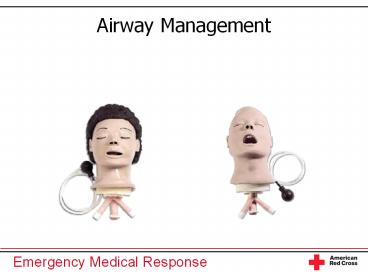Airway Management - PowerPoint PPT Presentation
1 / 13
Title:
Airway Management
Description:
Airway Management You Are the Emergency Medical Responder As border security in the immediate vicinity and trained as an emergency medical responder (EMR), you ... – PowerPoint PPT presentation
Number of Views:283
Avg rating:3.0/5.0
Title: Airway Management
1
Airway Management
2
You Are the Emergency Medical Responder
Lesson 15 Airway Management
- As border security in the immediate vicinity and
trained as an emergency medical responder (EMR),
you respond to a call at one of the docks for an
unconscious adult who collapsed for no apparent
reason. You size-up the scene and notice that a
middle-age male is lying prone on the floor and
not moving. You discover that the patients chest
does not rise when you attempt ventilations.
3
Suctioning
- Process of removing foreign matter, such as
mucus, fluid or blood, from a patients upper
airway - Two types of devices
- Mechanical electrically
- powered
- Manual hand powered
- no energy source
- Use of sterile suction catheters of appropriate
size
4
SuctioningClear Victims Airway
- Steps for Suctioning
- Turn head to side or roll body if head, neck, or
back injury suspected - Open victims mouth
- Sweep large particles of debris out of the mouth
- Measure distance of insertion (earlobe to corner
of mouth) - Insert suction device into back of mouth and
suction on the way out - No more than -
- Adults 15 sec Child 10 sec Infant 5 sec
5
Airway Adjuncts
- Mechanical airway adjuncts
- Oral (Oropharyngeal)
- airways (OPAs)
- Nasal (Nasopharyngeal) airways (NPAs)
- They keep the tongue (the most common cause of
airway obstruction) away from the back of the
throat. - OPAs are only for unconscious, unresponsive
patients with no gag reflex
6
Inserting An Oral Airway
- Select airway or proper size
- Victims earlobe to corner of mouth
- Open victims mouth using a crossed finger
technique - Insert airway with curved end along roof of mouth
- Advance airway gently until resistance is felt
- Rotate airway ½ turn
- Flange should rest on lips
7
Nasal Airway
- Uses
- Conscious, responsive patient
- Unconscious patient
- Contraindications for use
- Suspected head trauma
- Suspected skull fracture
- Lubrication of airway with water-soluble
lubricant is necessary - Insertion with bevel of airway toward septum
8
Inserting a Nasal Airway
- Select airway of proper size
- Measure from victims earlobe to tip of nose
- Lubricate nasal airway
- (K-Y jelly or other water based lubricant)
- Insert nasal airway into right nostril with bevel
toward MIDDLE of nose - Advance airway gently, until flange rests on nose
9
Airway Obstructions
- Anatomical obstruction from?
- The tongue
- Swollen tissues of the mouth, tongue or throat
- Mechanical obstruction from?
- Foreign objects, such as food or toys
- Fluids, such as vomit
10
Foreign Body Airway Obstruction (FBAO)
- Universal sign a conscious person who is
clutching the throat - Mild or partial FBAO
- Ability to move some air to and from the lungs
- Forcibly coughing, which is encouraged
- Severe FBAO
- Inability to cough, speak, cry or breathe
- Immediate action is necessary
11
Measures to Relieve FBAO
- Conscious patient
- Continued forcible coughing
- Back blows
- Abdominal thrusts (adults and children)
- Chest thrusts (for infants, pregnant women and
patients too large to reach around) - Unconscious patient
- Chest compressions
- Finger sweep if object is visible in the mouth
12
Scenario
- While attending a picnic, you notice that a
4-year-old boy begins coughing very forcibly
while eating a hot dog. His mother appears
frantic and begins shouting for help. As a
trained EMR, you respond to the mothers call for
help.
13
You Are the Emergency Medical Responder
- You reposition the patients airway and attempt
2 ventilations, but the chest still does
not rise.
After a few minutes of care, the patients chest
begins to rise and fall with the ventilations,
but he is not breathing on his own.































